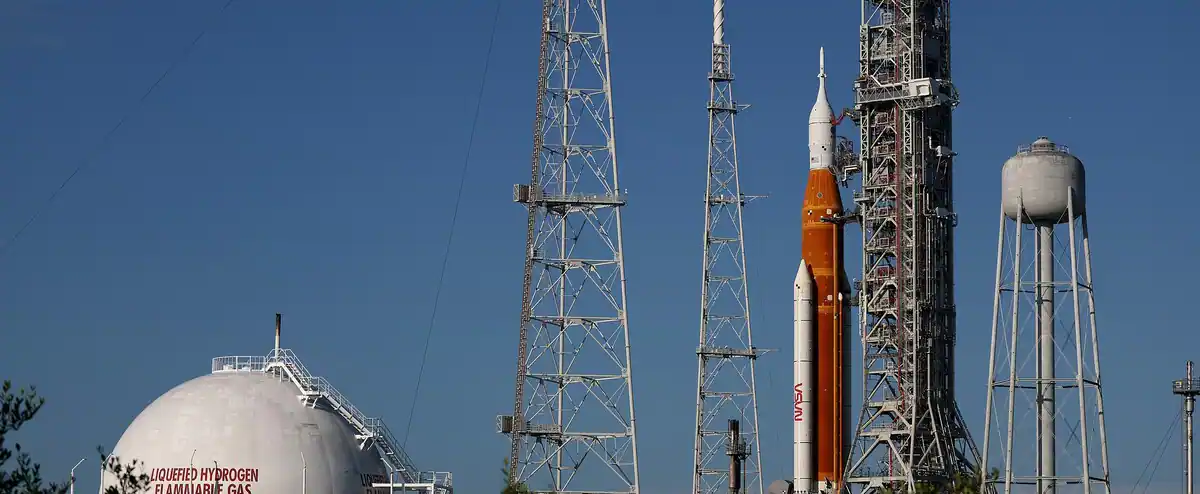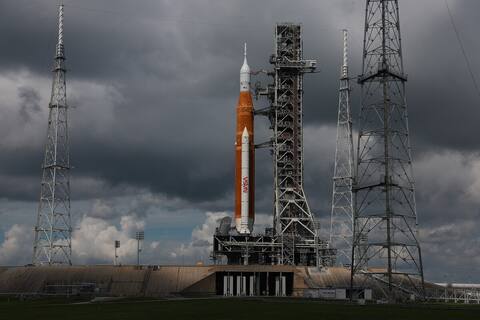Liftoff of NASA’s new mega-rocket for the moon was likely to be delayed on Monday after a series of technical and weather-related problems encountered during the craft’s complex preparations for launch on its first test mission.
• Read also: First stage of the return to the Moon
• Read also: Tourists flock to see the liftoff to the Moon
• Read also: NASA prepares to return to the Moon
Liftoff of Artemis 1 was originally scheduled for 8:33 a.m. (12:33 p.m. GMT) from launch pad 39B at Kennedy Space Center, Florida.
But it was “widely anticipated” that this schedule would not be adhered to, the NASA live video commentator said. The shooting window extends over two hours and therefore leaves room for manoeuvre. A new schedule has not yet been determined.
In the meantime, day was gradually breaking on the orange and white SLS rocket, 98 meters high.
The tanks of the rocket – the most powerful in the world – were gradually filled with more than three million liters of ultra-cold liquid hydrogen and oxygen. But the filling started about an hour late because of too high a risk of lightning in the middle of the night.
Then a leak caused a pause during the filling of the main stage with hydrogen, before a solution was found and the flow resumed.
Around 7:00 a.m. local time, a new issue was being investigated. One of the four RS-25 engines, under the main stage of the rocket, could not reach the desired low temperature — a condition necessary to be able to ignite it.
The countdown was stopped while the teams worked to establish an action plan.
In case of cancellation on Monday, the next possible take-off date is Friday, September 2.
“Dreams and Hopes”
Between 100,000 and 200,000 people were expected to attend the show, including United States Vice President Kamala Harris.
Fifty years after the last Apollo flight, the Artemis 1 mission should mark the launch of the American program to return to the Moon, which should allow humanity to then reach Mars, aboard the same vessel.
The Orion capsule will be launched unmanned into orbit around the Moon, to verify that the vehicle is safe for future astronauts — including the first woman and first person of color to walk on the lunar surface.
“This mission carries the dreams and hopes of many people,” said NASA boss Bill Nelson this weekend before adding: “We are now the Artemis generation.”
A sign of the times, NASA’s first female launch director, Charlie Blackwell-Thompson, will be responsible for giving the final “go”. Women represent 30% of the workforce in the launch room – against only one for Apollo 11.
Two minutes after takeoff, the boosters will fall back into the Atlantic. After eight minutes, the main stage will detach in turn. Then, after about an hour and a half, a final push from the upper stage will put the capsule on its way to the Moon, which it will reach after several days.
The main objective of the mission is to test the heat shield of the capsule, which will return to the Earth’s atmosphere at almost 40,000 km / h, and a temperature half as hot as the surface of the Sun.
Instead of astronauts, mannequins took place on board, equipped with sensors recording vibrations and radiation levels. Microsatellites will also be deployed to study the Moon, or even an asteroid.
The capsule will venture up to 64,000 km behind the Moon, farther than any other habitable spacecraft so far.
A complete failure of the mission would be devastating for a rocket with a huge budget (4.1 billion per launch, according to a public audit) and several years late (ordered in 2010 by the American Congress for an initial date of takeoff in 2017) .
Living on the Moon
“What we are starting with this liftoff on Monday is not a short-term sprint but a long-term marathon,” said Bhavya Lal, associate administrator at NASA.
After this first mission, Artémis 2 will carry astronauts to the Moon in 2024, without landing there. An honor reserved for the crew of Artemis 3, in 2025 at the earliest. NASA then wants to launch about one mission per year.
The goal: to establish a lasting human presence on the Moon, with the construction of a space station in orbit around it (Gateway), and a base on the surface.
There, humanity must learn to live in deep space and develop all the technologies necessary for a round trip to Mars.
A multi-year journey that could take place “at the end of the 2030s”, according to Bill Nelson.
But before that, going to the Moon is also strategic, faced with the ambitions of competing nations, notably China.


